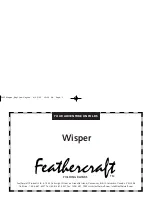
1-16
E
Overtaking
If you are passing another vessel, you are
the give-way vessel. This means that the
other vessel is expected to maintain its
course and speed. You must stay out of its
way until you are clear of it. Likewise, if
another vessel is passing you, you should
maintain your speed and direction so that
the other vessel can steer itself around you.
Other special situations
There are three other rules you should be
aware of when riding your watercraft around
other vessels.
Narrow channels and bends
When navigating in narrow channels, you
should keep to the right when it is safe and
practical to do so. If the operator of a power-
driven vessel is preparing to go around a
bend that may obstruct the view of other
water vessels, the operator should sound a
prolonged blast of four to six seconds on the
whistle. If another vessel is around the bend,
it too should sound the whistle. Even if no
reply is heard, however, the vessel should
still proceed around the bend with caution. If
you navigate such waters with your water-
craft, you will need to carry a portable air
horn, available from local marine supply
stores.
Fishing vessel right-of-way
All vessels fishing with nets, lines or
trawls are considered to be “fishing vessels”
under the International Rules. Vessels with
trolling lines are not considered fishing ves-
sels. Fishing vessels have the right-of-way
regardless of position. Fishing vessels can-
not, however, impede the passage of other
vessels in narrow channels.
Sailing vessel right-of-way
Sailing vessels should normally be given
the right-of-way. The exceptions to this are:
1. When the sailing vessel is overtaking the
power-driven vessel, the power-driven
vessel has the right-of-way.
2. Sailing vessels should keep clear of any
fishing vessel.
3. In a narrow channel, a sailing vessel
should not hamper the safe passage of a
power-driven vessel that can navigate
only in such a channel.
Reading buoys and other
markers
The waters of the United States are
marked for safe navigation by the lateral
system of buoyage. Simply put, buoys and
markers have an arrangement of shapes,
colors, numbers and lights to show which
side of the buoy a boater should pass on
when navigating in a particular direction.
The markings on these buoys are oriented
from the perspective of being entered from
seaward (the boater is going towards the
harbor). Red buoys are passed on your star-
board (right) side when proceeding from
open water into the harbor, and black buoys
are to your port (left) side. An easy way to
remember the meaning of the colors is the
phrase “red right returning.” When navigat-
ing out of the harbor, your position with
respect to the buoys should be reversed; red
buoys should be to port and black buoys to
starboard.
Many bodies of water used by boaters are
entirely within the boundaries of a particular
state. The Uniform State Waterway Marking
System has been devised for these waters.
E_F1N-10.book Page 16 Thursday, June 2, 2005 9:56 AM
Содержание 2006 SuperJet 700
Страница 2: ......
Страница 8: ...1 3 E EJU00998 Important labels EJU01351 Label location ...
Страница 9: ...1 4 E EJU01352 Warning labels 1 2 3 ...
Страница 10: ...1 5 E 5 6 7 4 ...
Страница 11: ...1 6 E EJU01354 Other labels 0 8 9 A B ...
Страница 36: ...E MEMO ...
Страница 72: ...E MEMO ...
Страница 105: ...E 6 EJU01124 APPENDIX Limited warranty 6 1 YAMAHA EXTENDED SERVICE Y E S 6 3 Index 6 4 ...
Страница 111: ...Printed in Japan Jun 2005 0 5 1 CR F1N 28199 14 E Printed on recycled paper YAMAHA MOTOR CORPORATION USA ...
















































